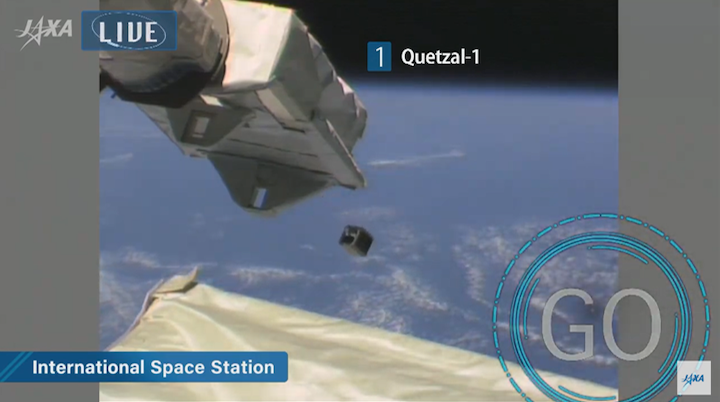4.05.2020
National Research & Development Agency
Japan Aerospace Exploration Agency (JAXA)
On April 29th, 2020 (Japan time), the CubeSat developed by a team from the Universidad del Valle de Guatemala was successfully deployed from the Japanese Experiment Module “Kibo” of the International Space Station. This CubeSat, named “Quetzal-1” was selected as the winner of the Second Round of KiboCUBE programme.(*) The live streaming of the deployment was broadcasted online, and many people in Guatemala watched the successful deployment of their first national satellite through live streaming.
Quetzal-1 was developed as Guatemala’s first satellite, and the Universidad del Valle de Guatemala will operate the CubeSat after its deployment from “Kibo.” The knowledges earned from the observation data of Quetzal-1 will be applied in Guatemala’s future remote sensing technology.
| (*) | KiboCUBE is a cooperative programme between UNOOSA and JAXA to offer opportunity to deploy CubeSats from “Kibo.” This programme aims to improve space technology of the developing and emerging space nations of the United Nations member states. |
|---|
Schedule of Quetzal-1 (Japan time)
- September 11th, 2017 Announcement of Selection as the second round of KiboCUBE
- December 6th, 2019 Handover of Quetzal-1 to JAXA
- March 7th, 2020 Launch to the ISS
- On April 29th, 2020 Deployment from “Kibo” using JEM robotic arm

Mr. Hiroshi Sasaki, Director General, JAXA Human Spaceflight Technology Directorate
We are relieved that the CubeSat (Quetzal-1) of the University del Valle de Guatemala, which was selected as the 2nd KiboCUBE program, was steadily released, and we would like to extend our respect to UNOOSA and the University del Valle de Guatemala for their efforts. We hope that the experience and knowledge obtained through the development and technical demonstration of Quetzal-1 will lead to the further development of remote sensing technology in the Republic of Guatemala in the future. We are also proud to contribute to the development of space technology in Guatemala through the utilization of the Japanese Experiment Module “Kibo”. Lastly, congratulations on the successful deployment of the first satellite of the Republic of Guatemala from “Kibo”!
Ms. Simonetta DiPippo, Director, United Nations Office for Outer Space Affairs (UNOOSA)
Together with JAXA, our partners in the KiboCUBE project that made this deployment possible, we are delighted to welcome Guatemala to the growing community of space-faring nations! We stand ready to continue to support the utilization of this CubeSat and the overall development of the space sector in Guatemala. Today you made us immensely proud of having being part of this historic achievement.
Mr. Roberto Moreno, Rector, Universidad del Valle de Guatemala
Today is a very special day for the members of Universidad del Valle, as well as for all Guatemalans. Finally, the first Guatemalan satellite was deployed from the International Space Station, after having been sent into space in March. This is a very important project for our community, with a deep sense of ownership by all units of the University, including not only the academic area, but all administrative and support areas. We are proud of the talented group of students, alumni, and professors that form part of a group of over one hundred members of our students and staff that made it possible. The deployment of this satellite into space is a tangible evidence of the fulfillment of the mission of Universidad del Valle de Guatemala, which aims to put science, technology, and education to the service of society and to prepare the highly needed change agents that will contribute to the development of the region. The message that we are sending today with the deployment of Quetzal-1 is a one of hope and optimism, demonstrating that we can accomplish challenging goals, join efforts, serve our communities and live meaningful lives.
Quelle: JAXA
